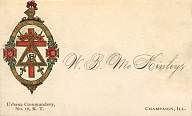
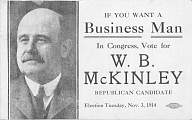
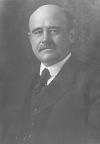

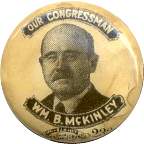
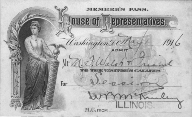



We cannot end this book without discussing the man who made much of it possible. William B. McKinley was not the founder of the Urbana-Champaign system; he was not the first man to electrify horsecar lines; he was not the only interurban promoter to succeed. But in the Twin Cities, and in central Illinois, he was the man who made it all happen.
William Brown McKinley was born September 5, 1856 in Petersburg, Illinois. His father was George McKinley, a Presbyterian minister. His mother Hannah was a daughter of Robert Finley, one of the first presidents of the University of Georgia. He was named for an uncle, William Brown, a judge in Jacksonville, Illinois.
After eleven years as pastor in Petersburg, George McKinley in 1857 moved to the Presbyterian Church in Middletown (present day Mahomet). In 1858 he moved again, to the First Presbyterian Church in Champaign, where his brother James had opened a law practice the previous year. His children were educated in the public schools of Champaign. He retired from the First Presbyterian in 1870 due to ill health. He died in 1887; his widow survived until 1892.
Young William McKinley entered the University of Illinois at the tender age of 14. He studied there for about two years, then dropped out for lack of money and, about 1875, took a position as a drug store clerk in Springfield, at a salary of $4.50 a week. Shortly after, he went to work in Champaign for his uncle, J. B. McKinley, in the farm mortgage business.
James B. McKinley had moved to Champaign in 1857 and opened a law office. Although he practiced law until 1860, he soon became interested in lending money. He was among the first in Illinois to make farm mortgages using eastern capital. In 1877, he employed his nephew William, and a few years later, made him a partner in the business. He continued to be active as a farm mortgage broker after his nephew and partner turned to other interests. He was one of the founders of the Champaign National Bank, serving for several years as its First Vice-President and as a Director. He also served as mayor of Champaign for part of the year 1883. He died October 23, 1903.
On February 23, 1881, William McKinley married Kate Frisbee of Chicago. She was born January 9, 1856, in Ogle County, Illinois, the daughter of John W. Frisbee and Phrocine Whiteside. The couple settled in Champaign. They never had children, and they were separated by 1896, perhaps because of her chronic ill health. However, they never divorced; in fact, McKinley left money to his wife in his will. She died at Southern Pines, North Carolina, on January 28, 1940.
After a few years in the farm mortgage business, William McKinley had become acquainted with the sources of eastern capital, and had begun to envision other uses for this money. In 1884, he entered the field of public utilities, building the first water works to supply Champaign and Urbana. Soon after, he also built the first electric lighting plant for the two cities, housing the generators in the water works buildings.
He entered the public transportation field in 1890. In that year, he bought, electrified, and expanded the horsecar line between Urbana and Champaign. He also bought the gas and electric plants in Defiance, Ohio, and built a street railway there.
In 1891, McKinley had his first fling with politics. That spring, he ran for a seat on the Champaign city council as alderman from the Fourth Ward, but he was defeated by J. R. Scott, 165 to 118.
In 1892, he sold his utilities holdings in Champaign-Urbana, and bought and electrified horsecar lines in Springfield, Ohio and Bay City, Michigan.
In the meantime, he was still active in the farm mortgage firm of J. B. and W. B. McKinley. The firm had opened branch offices in Hastings, Nebraska and McPherson, Kansas. The panic of 1893 found the firm holding thousands of dollars of farm mortgages in those states. McKinley seems to have made every effort to avoid foreclosure, and also to reimburse those who had bought mortgages from his firm. It is said that by 1903, all the loans had been made good. During this period, he sold most of his utilities, and temporarily dropped out of the field of electric power in Illinois.
In 1896, McKinley became involved in plans to extend the Joliet, Illinois street railway system to Chicago. This was his first interurban project, and was perhaps the first interurban in the state. An eleven mile line was built at this time, but the line did not reach Chicago until 1901, long after McKinley had sold his interest in it.
In 1898, he bought and modernized the street railways in Quincy and Galesburg, Illinois, and built a suburban line from Galesburg to Knoxville. In 1899, he bought back the Urbana and Champaign street railway and the gas and electric utilities. Then he acquired the Danville street railway in 1900, and built suburban lines from Danville to Westville and Catlin the following year. These lines were the beginnings of the future Illinois Traction System.
McKinley was one of the promoters of the Fort Wayne and Southwestern Traction Company, which in 1901 built the first interurban line out of Fort Wayne, Indiana, a line to Huntington.
Most of his projects after this time were in Illinois. The Illinois Traction System was expanded into an important interurban system, and about fifteen local street railways and numerous gas, electric, and heating utilities were organized into the Illinois Traction Company and the Western Railways and Light Company. These projects were financed primarily by money from Canada and England. Most were complete by 1911.
As these projects grew more and more vast, McKinley's personal part in them became more and more that of general planning and financing; the operations were increasingly left to others. Yet he seems to have stayed in touch with many of these details, and apparently made efforts especially to be in touch with the people involved. For example, he is frequently found hosting dinners and parties for employees. And his direct intervention was sought in labor disputes from time to time—by the employees! A number of such disputes were settled satisfactorily with his assistance, without a strike.
In 1902, McKinley reentered the field of politics. Running as a Republican, he was elected to a seat on the University of Illinois Board of Trustees. He served in that post until 1905.
William McKinley first ran for Congress in 1904. The Champaign and Urbana newspapers supported his candidacy warmly, and he was elected easily. He was reelected three times.
Then in 1912, while running again for re-election, McKinley was manager of William Howard Taft's campaign for re-election to the presidency. But the Republican Party was badly split that year, and both the President and his campaign manager lost their bids.
McKinley spent part of his two years out of office traveling. He returned to Champaign-Urbana in March 1914, to an enthusiastic public “welcome home” celebration. Running again for his former seat in Congress, he was elected handily over the same man who had defeated him two years earlier.
He was reelected twice more to the U. S. House of Representatives, serving through the sixty-sixth Congress (1919-1921). He then ran for the Senate and was elected.
William McKinley served almost a full term in the Senate before being stricken by prostate cancer in mid-1926. After a lingering illness, he died at Martinsville, Indiana on December 7, 1926. The funeral was held in Champaign, and he was buried in Mount Hope Cemetery.
William B. McKinley is remembered today, not only as a great utilities magnate, interurban builder, and congressman, but also as a philanthropist. Many of his generosities were not publicized, while others were named for him or, at his request, in memory of his father, George McKinley. A number of well known buildings and institutions in the Twin Cities were named in gratitude for his generosity: for example, McKinley Health Center at the University of Illinois, McKinley Presbyterian Church (named for his father), McKinley YMCA, McKinley Athletic Fields at both the Urbana and the Champaign High Schools. (There is also a Champaign street named for his father.) He had accumulated a large fortune, but he once told his fellow Congressman from Illinois, Charles Adkins, “that he believed that every citizen who makes a large fortune in a community should give some of it back to that community by helping worthy public enterprises and institutions.”
References for this chapter:
William B. McKinley, Memorial Addresses Delivered in Congress,
U. S. Government Printing Office, 69th Congress, 2nd Session, Senate Document
No. 215, 1927.
The Historical Journal of the More Family, Vol. 3, No. 11,
November 1940, pp. 347-349.
Computer Science Department, University of Illinois at Urbana-Champaign, Home Page